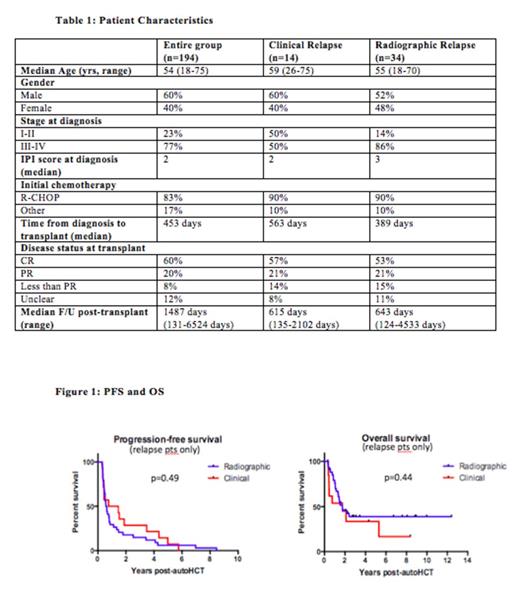Abstract

Background
It is common for diffuse large B-cell lymphoma (DLBCL) patients following autologous hematopoietic transplant (auto-HCT) to undergo surveillance imaging to monitor for lymphoma progression/relapse. Although a standard at most centers, this practice is not evidence-based, has not been shown to improve survival, and may pose a risk to patients due to radiation exposure. We studied DLBCL patients who underwent auto-HCT at three transplant centers to define how many surveillance imaging studies were obtained, how often relapses were detected by surveillance imaging versus clinically (based on signs, symptoms or laboratory findings), and whether survival was improved if relapse was detected by imaging versus clinically.
Methods
DLBCL patients who underwent auto-HCT during 2000-2013 were identified using clinical databases. Pre-transplant patient and disease characteristics were collected. Progression-free survival (PFS) and overall survival (OS) were determined. Patients were classified as having "radiographic" or "clinical" relapses. PFS and OS were compared for these two groups.
Results
A total of 209 patients with DLBCL who underwent auto-HCT between 2000 and 2013 were identified. There was insufficient follow-up information on 15 patients and hence only 194 patients were evaluable. Of these, 22 patients relapsed or progressed prior to or at their initial post-transplant disease assessment (day 100 evaluation). The remaining 172 patients were then analyzed to determine which patients relapsed and how relapses were detected. 48 patients relapsed at a median time of 287 days post-transplant. Of these patients, 14 (29%) had relapse detected clinically and 34 (71%) had relapse detected by surveillance imaging. Comparing the radiographic and clinically detected groups, median PFS post auto-HCT was 218 vs 402 days respectively (p= 0.49, log rank test, Figure 1) and median survival post auto-HCT was 643 vs 615 days respectively (p= 0.44, log rank test, Figure 1). For patients who never relapsed after auto-HCT, a median of 4 surveillance imaging studies were performed (with median follow up of 3.0 years post-transplant).
Conclusions
In DLBCL patients post auto-HCT, the majority of relapses were detected by surveillance imaging. However, the survival of patients with relapse detected by surveillance imaging was not superior to those whose relapse was detected clinically. Given this, combined with the radiation exposure and cost associated with surveillance imaging, the practice of surveillance imaging post auto-HCT appears to have limited utility in DLBCL.
Hari:Janssen: Consultancy; Novartis: Consultancy; Spectrum: Consultancy; Sanofi: Consultancy; Takeda: Consultancy; Celgene: Consultancy; BMS: Consultancy. Hamadani:Takeda: Research Funding; Cellerant: Consultancy; Celgene: Consultancy; MedImmune: Consultancy. Fenske:Celgene: Honoraria; Pharmacyclics: Honoraria; Seattle Genetics: Honoraria; Millennium/Takeda: Research Funding.
Author notes
Asterisk with author names denotes non-ASH members.

This icon denotes a clinically relevant abstract


This feature is available to Subscribers Only
Sign In or Create an Account Close Modal